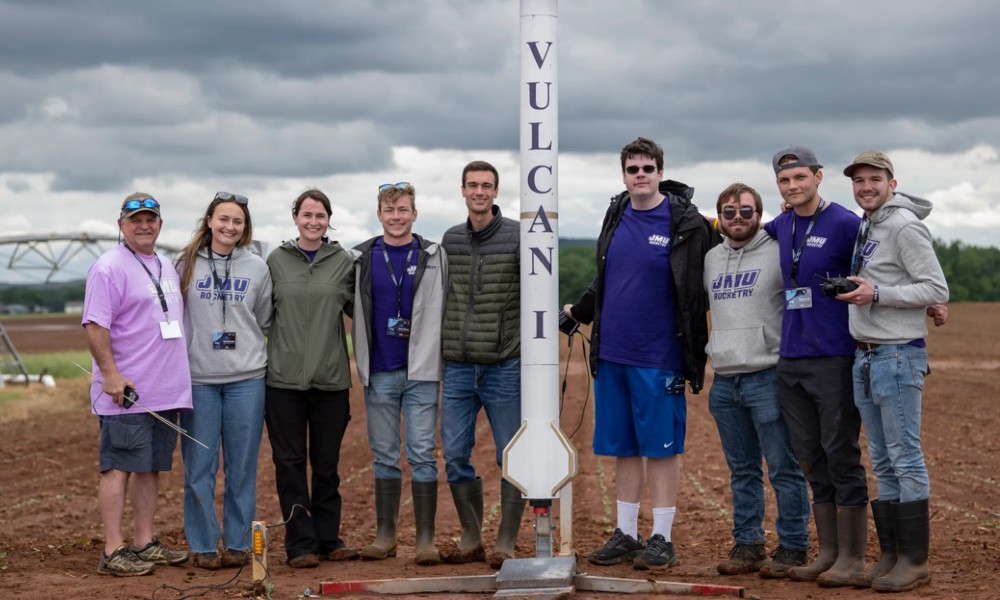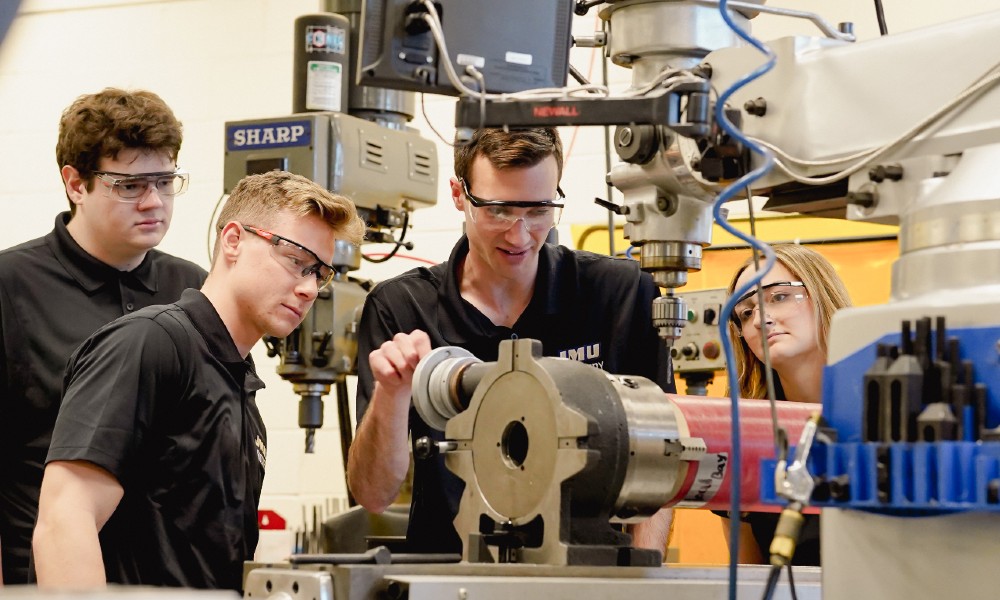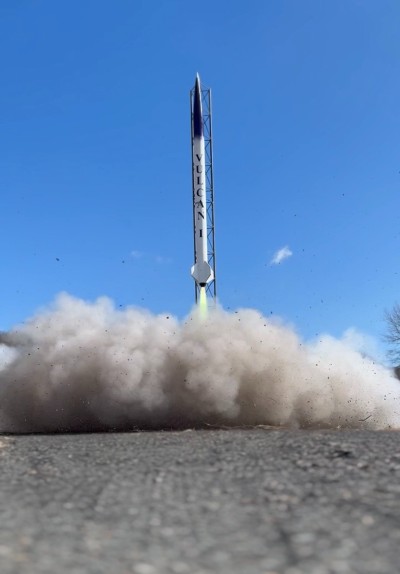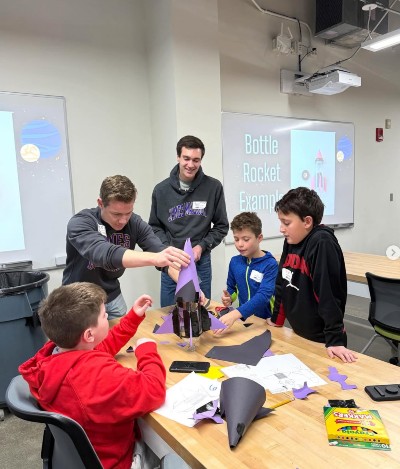Eight engineering students, one rocket and a NASA victory
The inside story of teamwork, perseverance and triumph
News
SUMMARY: JMU Engineering students took on the challenge of NASA’s Student Launch competition, emerging as first-place winners against some of the nation’s top aerospace programs. Their story goes beyond rocket science, revealing a journey of teamwork, perseverance and creativity that exemplifies the strength of JMU’s Engineering program.
In a year marking the 25th anniversary of NASA’s Student Launch competition, a team of eight senior James Madison University engineering students — now proud alumni — achieved something extraordinary: first place overall, outperforming more than 50 top-tier university teams, including MIT, Purdue, Notre Dame, Vanderbilt, Georgia Tech and Virginia Tech.
But their success wasn’t just about rockets. It was about grit, teamwork, leadership and the distinct way JMU Engineering prepares students for the real world.
From the ground up
Long before liftoff in Huntsville, Alabama, the team behind Project Vulcan I was laying a different kind of groundwork — assembling not just parts, but a team culture built on shared purpose and commitment.
|
“We all chose this challenging capstone to develop new skills and prove that JMU engineers could be competitive in the aerospace industry.” — Josiah Walker |
The team organized before NASA’s 2025 competition was even announced, studying past challenges and preparing to hit the ground running.
During this preparation period, several members of the vehicle structure and avionics/recovery subteams earned their Level I certifications with Valley Aerospace Team. This extra step strengthened their technical skills and was the beginning of a mentorship with Chuck Neff, president of VAST. “Constructing and flying these rockets gave us experience with everything from epoxy application techniques to selecting motors and running pre-flight simulations in software like OpenRocket,” said Owen Bailey, vehicle structure lead.
Their efforts paid off early. Their proposal earned rare praise from judges as one of the best in years.
“Usually, the only feedback a team receives is whether or not they got accepted into the competition, but we received a comment from a judge within a few days,” said Josiah Walker, member of the vehicle structure team.
With this encouragement, the team began developing their Preliminary Design Report — the first scored deliverable. “It required us to schedule out the project, plan our budget, create a safety plan, and begin preliminary design on the rocket frame, avionics system, and payload,” Walker said. “We had to simulate both the full-scale and subscale designs and identify the components we needed to purchase.”
A small but mighty team
Unlike larger teams from well-resourced aerospace programs, JMU’s Vulcan I was a crew of eight. “Many of these teams competed with 20-40 members,” said Grant Whitlow, team lead.
Their small size meant everyone took on multiple responsibilities — leading subteams, managing outreach, collaborating across vehicle design, payload, avionics and recovery.
Their thoughtful approach to leadership reinforced their dynamic. “We conducted a democratic vote for the leading positions, and everyone was perfectly fit into their roles from the beginning,” said Matthew Smith, safety officer.
The team’s cohesion and preparation became essential when technical and logistical hurdles arose.
As deadlines approached for their full-scale demonstration flights in spring 2025, supply chain issues became a serious obstacle. “The national appeal of the competition meant all the teams were ordering components from the same group of vendors,” Bailey explained.

(L-R): Ethan, Grant, Owen and Lily work on the full-scale build of Vulcan 1 in JMU’s Engineering Lab.
Rather than let delays derail their timeline, they adapted — working around the clock, refining their design, and relying on Whitlow’s persistence with vendors. “The day our parts arrived, we banded together and finished construction in just three days,” Bailey said.
Their success was all the more remarkable given the demands of senior year. “This project was very demanding,” said Katelyn Marshall, project manager. “But every team member was willing to dedicate the time it took — sometimes missing classes, working weekends or staying late. We made detailed schedules and supported one another through it all.”
“Many of us knew what we were signing up for and made sure our course loads would allow us to commit fully. The entire team was all in,” Walker said.
The launch

Launch day arrived May 4 in Huntsville. As NASA’s announcer counted down — “5, 4, 3, 2, 1” — the Vulcan I rocket lifted off flawlessly. When the parachute deployed, it landed directly in front of the team and the judges, capping a near-perfect mission.
Weeks later, on June 13, the NASA announcement came: Vulcan I had won first place overall — a remarkable achievement for one of the smallest teams competing against some of the country’s largest programs.
And that’s not all. The team also earned first place in the American Institute of Aeronautics and Astronautics Payload Innovation Award, as well as second place in AIAA’s Reusable Launch Vehicle Award — a testament to their creativity, technical skill, and ability to adapt their design thoughtfully to meet the challenge.
After carefully listening to what the judges were looking for, Walker and his team reimagined the payload as a spacecraft-inspired enclosure complete with Lego astronauts. “These creative changes won the judges over with our style points, creating a name and brand for our team,” Walker said. “We kept our design simple and high performing.”
“When the judges gave us requirements, we conducted careful research and trade studies to explore many possible solutions while also considering our skills,” he said. “We ultimately chose a system of computers and sensors that reduced risk and performed nearly flawlessly on competition day.”
A JMU approach to engineering
JMU’s approach to engineering education was a major factor in the team’s success. Students work on complex and broad-scope projects in teams throughout their entire undergraduate journey.
|
“Fundamental to the JMU engineering curriculum, from freshman through senior year, we work in teams and on projects in nearly every engineering course. This skillset allowed our team to set goals early, communicate transparently, lead each other well, and hold each other accountable.” — Grant Whitlow |
“JMU Engineering teaches students how to learn quickly, adapt effectively, and build upon a strong technical foundation,” said Ethan Specht, software lead. “In our circuits and instrumentation course, we’re taught material that would typically be covered in multiple semesters at a traditional electrical engineering school. At the end of one semester, we had the knowledge and practical skills required to design circuits ranging from simple battery testers to sound frequency detectors — and that knowledge was instrumental in our payload’s electronic system design.”
Mentorship and unseen support
While this was a student-led endeavor, their success was made possible by the support of dedicated faculty, staff, and mentors. Dr. Steven Woodruff, professor of engineering, was pivotal — not only advising the team but also reviving JMU’s participation after a gap year. “Dr. Woodruff met with us weekly, helping troubleshoot challenges and guiding without micromanaging,” Bailey said. “He ensured we had the freedom to learn and lead while being there when we needed technical guidance.”
The team’s relationship with Neff was equally essential. “Chuck Neff was an integral part of the team’s victory,” Whitlow said. “His knowledge, expertise, and mentorship went far beyond what was expected, and our achievement would not have been possible without his support.”
“He dedicated weekends to testing, took a week off work for the competition, and was always there to share his expertise — even at 2 a.m.,” Bailey added.
“It was an honor to work with these students,” Neff said. “From our first meeting, I told them that I’d support them in any way I could, and that communication would be key. They did an incredible job asking thoughtful questions and building on the answers they received. I look forward to continuing this relationship with future JMU Rocketry teams.”
Engineering faculty ensured the team had the resources, spaces and materials to succeed, while staff coordinated procurement, travel and logistics under tight deadlines. “Our success was heightened by the incredible encouragement and support of our classmates, peers, parents, and community partners,” Whitlow said.
Inspiring the next generation

That commitment extended beyond the competition itself. The Vulcan I team reached more than 400 K–12 students through hands-on outreach.
“We organized workshops where students participated in activities like building bottle rockets and moon landers, helping them understand the principles of flight and design through direct experience,” said Lily DeBruycker, outreach lead.
“One of our favorite activities was running the Madison Aerospace Club, where students got the chance to build a Level 1 rocket with our guidance and then launch it in the spring,” she said. “Watching their excitement and sense of accomplishment was incredibly rewarding for everyone involved.”
The team visited local schools, tailoring presentations and creating educational materials for different age groups. “After each event, we collected feedback to make every outreach better than the last,” DeBruycker said. “Our outreach efforts focused not just on sharing knowledge, but on inspiring curiosity in the next generation of engineers.”
A defining experience
For every member, Vulcan I was transformative. The project challenged them to grow as engineers and leaders, teaching them to foster high-performing teams, lead and delegate effectively, collaborate across different skill sets, and apply their technical knowledge to real-world problems.
|
“The passion and shared commitment of every member fueled their victory. Every member and leader played critical roles in the competition.” — Matthew Smith |
The project challenged me to apply my technical knowledge in avionics, embedded systems and hardware integration to real-world problems, enhancing my problem-solving abilities and practical engineering skills,” said Thomas Vancil, avionics and recovery lead.
The team’s members are already charting impressive paths: Smith, Walker and Vancil are continuing their education in aerospace engineering; Bailey is launching a start-up while seeking a role in the aerospace industry; Whitlow has joined Northrop Grumman as a systems engineer; DeBruycker and Marshall have begun their careers as project engineers; and Specht is considering a career in defense contracting.
"We are incredibly proud of our capstone team for winning this year’s NASA Student Launch competition,” Woodruff said. “Their dedication, creativity and perseverance exemplify the very best of our program.”
“We’re proud to have represented JMU on a national stage and can’t wait to see what future rocketry teams will achieve,” Whitlow said.
Learn more about JMU Rocketry and follow their story on Instagram.
